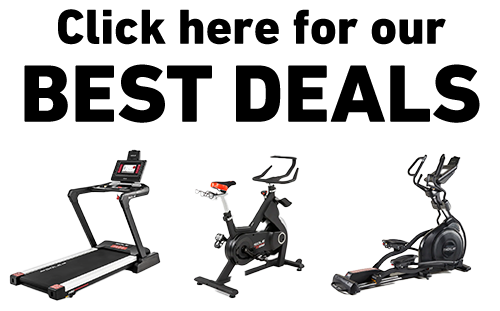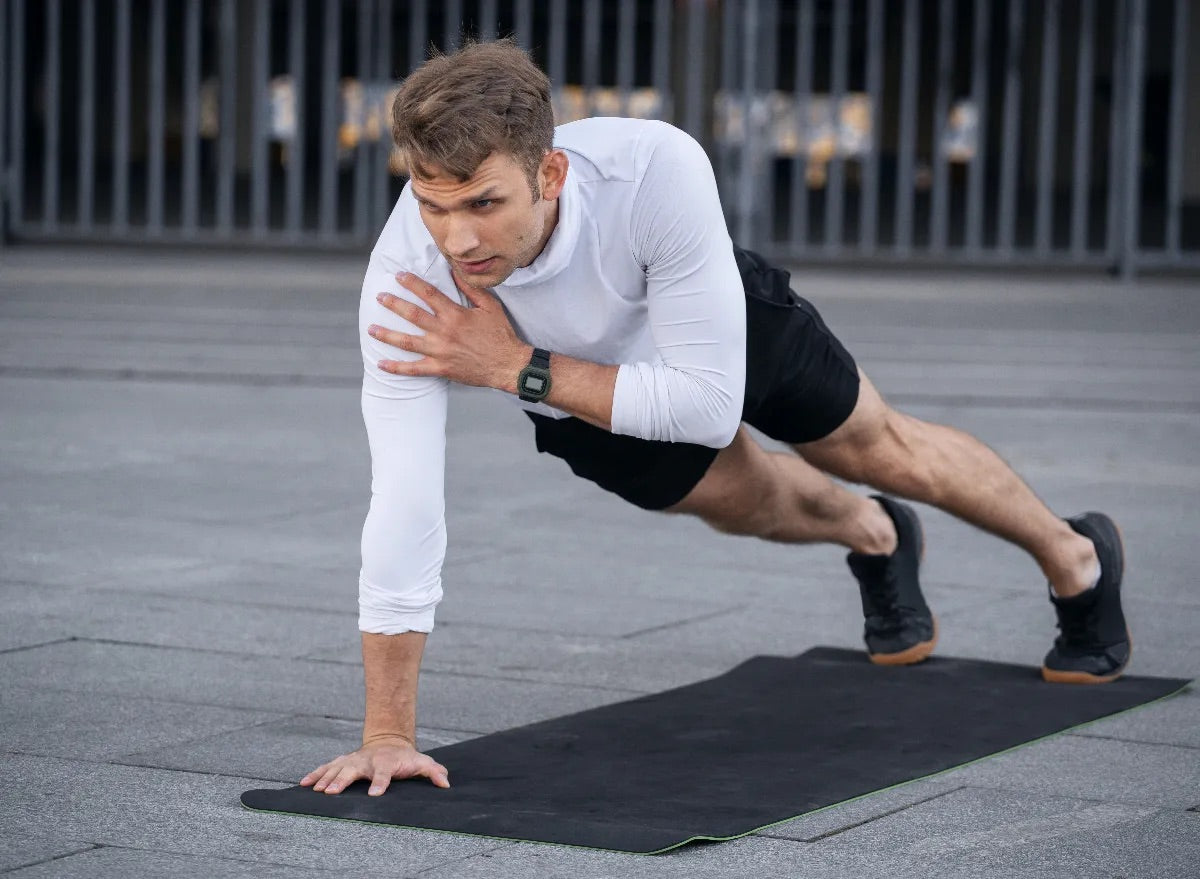Key Takeaways
- Mountain climbers excel at core activation and sustained cardio, while burpees deliver superior full-body muscle engagement and calorie burn in less time.
- Both exercises work multiple muscle groups simultaneously, making them efficient choices for HIIT workouts and metabolic conditioning.
- Mountain climbers are generally more beginner-friendly and joint-protective than burpees, which have a steeper learning curve but offer greater intensity.
- SOLE Fitness equipment provides excellent complementary fitness tools to maximize the benefits of bodyweight exercises like mountain climbers and burpees in a comprehensive fitness program.
The Ultimate Showdown: Mountain Climbers vs Burpees
Looking to maximize your workout efficiency? You've likely encountered both mountain climbers and burpees in fitness classes or training programs.
Mountain climbers and burpees both qualify as compound movements that engage multiple muscle groups simultaneously. However, they differ significantly in execution complexity, intensity level, and specific muscle activation patterns.
While mountain climbers keep you in a relatively stable position with dynamic lower body movement, burpees take you through a complete range of motion from horizontal to vertical positions, challenging your body's coordination systems in different ways.
If you're integrating these movements into your home workout or using them alongside commercial-grade equipment, knowing exactly how mountain climbers and burpees compare will help you design more effective training sessions.
|
Premium Home Gym Equipment with Award-Winning Quality!
Why Choose SOLE: ✓ Commercial-grade quality for home use 30-Day Money-Back Guarantee: Love it or return it, no questions asked. |
Muscle Activation: Which Exercise Works More Muscles?
Mountain Climber Muscle Map
Mountain climbers create an impressive cascade of muscle activation throughout your body.
The primary muscles targeted in the mountain climber's exercise include the rectus abdominis, obliques, and transverse abdominis, which work continuously to stabilize your torso throughout the movement.
Your shoulders (deltoids) and chest (pectoralis major and minor) maintain isometric contractions to hold the plank position, while your triceps work to keep your elbows extended.
In your lower body, the hip flexors (iliopsoas) are heavily recruited as you drive your knees toward your chest. The quadriceps engage to extend your knees as you alternate legs, while your hamstrings and glutes assist in the driving motion of each "climb."
Even your calves get significant activation as they help stabilize your ankles throughout the exercise. What makes mountain climbers particularly effective is the constant tension maintained in your core muscles, which must work continuously to prevent your hips from sagging or rising too high.
Burpee Muscle Engagement Breakdown
Burpees generally engage more total muscle mass due to their multi-phase nature that includes elements of a squat, plank, push-up, and jump.
The specific muscle activation in burpees typically depends on the phase.
Burpee Phase-by-Phase Muscle Activation
- Squat Phase: Quadriceps, hamstrings, glutes, calves, core stabilizers
- Plank Position: Shoulders, chest, triceps, core (all regions), lower back
- Push-up Component: Chest, shoulders, triceps, core, serratus anterior
- Jump Phase: Quadriceps, glutes, calves, hip flexors, shoulders are all engaged during the jump phase of a burpee.
- Throughout Full Movement: Core muscles (continuous stabilization)
What makes burpees particularly challenging is the rapid transition between phases, requiring strength, coordination, and body control.
The exercise demands your cardiovascular system work overtime to supply oxygen to these large muscle groups working simultaneously, creating that signature "out of breath" feeling even after just a few repetitions.
The explosive nature of burpees, particularly during the jump phase, recruits fast-twitch muscle fibers that are crucial for power development. This makes burpees especially valuable for athletes needing to improve power output alongside conditioning.
Lower Body Muscle Recruitment
Both exercises challenge your lower body extensively, but in different ways. Mountain climbers create a more isolated and repeated challenge to your hip flexors and quadriceps, with moderate engagement of the hamstrings and glutes.
The movement pattern resembles running mechanics, making it particularly beneficial for runners looking to improve their stride power and knee drive.
Burpees demand greater explosive power from your lower body, particularly during the jump phase. The squat portion engages your quadriceps, hamstrings, and glutes through a full range of motion, while the explosive jump activates fast-twitch muscle fibers.
This makes burpees superior for developing lower body power, while mountain climbers excel at building endurance in these same muscle groups.
Calorie Burn and Cardio Benefits
For calorie-burning potential, both exercises are powerhouses.
EPOC Effect: Why These Exercises Torch Calories
The real magic of both mountain climbers and burpees lies in their ability to generate excess post-exercise oxygen consumption (EPOC), commonly known as the "afterburn effect."
This physiological response keeps your metabolism elevated for hours after your workout ends. The high-intensity nature of these exercises creates significant oxygen debt, requiring your body to work harder during recovery to restore normal oxygen levels, repair muscle tissue, and replenish energy stores.
What makes both exercises particularly effective for fat loss is their combination of strength and cardio elements in a single movement. This dual stimulus preserves muscle mass while targeting fat stores, creating a more favorable body composition change than steady-state cardio alone could produce.
Heart Rate Response During Each Exercise
The cardiovascular response to mountain climbers tends to build more gradually, allowing for better sustained effort over time. The steady nature of the movement pattern allows your cardiovascular system to find a sustainable rhythm, even during high-intensity work periods.
Burpees, by contrast, create a more dramatic spike in heart rate. The rapid position changes from horizontal to vertical create significant cardiovascular challenges as your body works to maintain blood flow and oxygen delivery during these transitions.
For optimal cardiovascular development, combining both exercises in a structured program allows you to train different energy systems and cardiovascular responses. Mountain climbers excel at building aerobic endurance, while burpees are superior for developing anaerobic power and lactate threshold.
Time Efficiency: Maximum Results in Minimal Time
If your primary concern is maximizing results with minimal time investment, burpees offer slightly greater efficiency.
A 4-minute Tabata protocol (20 seconds work, 10 seconds rest) using burpees creates a comprehensive full-body workout that challenges every major muscle group while delivering significant cardiovascular benefits.
Mountain climbers, while still highly time-efficient, generally require slightly longer work periods to achieve comparable training effects. However, they offer the advantage of being easier to maintain with proper form during extended intervals.
Comprehensive Comparison: Mountain Climbers vs Burpees
|
Feature |
Mountain Climbers |
Burpees |
|
Primary Muscle Groups |
Core (rectus abdominis, obliques, transverse abdominis), shoulders, chest, triceps, hip flexors, quadriceps, hamstrings, glutes, calves |
Full body: legs (quadriceps, hamstrings, glutes, calves), core, shoulders, chest, triceps, serratus anterior |
|
Movement Pattern |
Dynamic lower body alternating knee drives while holding plank position |
Multi-phase: squat, plank, push-up, jump with rapid transitions |
|
Muscle Activation |
Continuous core stabilization; moderate lower body endurance focus |
Explosive power; intense full-body muscle engagement |
|
Calorie Burn |
High calorie burn via sustained cardio; builds aerobic endurance |
Higher calorie burn in shorter time; builds anaerobic power |
|
Cardiovascular Effect |
Steady heart rate increase, sustainable over longer periods |
Rapid heart rate spikes; intense cardiovascular challenge |
|
Difficulty Level |
More beginner-friendly, joint-protective |
Higher intensity, steeper learning curve, requires coordination |
|
Lower Body Focus |
Endurance and repetitive hip flexion; good for running mechanics |
Explosive strength, fast-twitch muscle recruitment in jump phase |
|
Calorie Burn Duration |
Sustained calorie burn potential in longer sessions |
Greater immediate calorie burn, EPOC (“afterburn”) effect stronger |
|
Suitable For |
Those prioritizing core strength, endurance, and joint safety |
Those wanting full-body conditioning, power, and high-intensity interval training |
|
Workout Integration |
Excellent for longer intervals, cross-training for runners |
Ideal for Tabata/high-intensity intervals, short duration explosive training |
|
Complementary Equipment |
Can be paired with cardio machines and strength training for endurance |
Complements strength equipment and cardio machines for power and conditioning |
SOLE Fitness: Building Your Complete Fitness Foundation
At SOLE Fitness, we understand that sustainable fitness success comes from variety, progression, and the right tools working together. Mountain climbers and burpees are powerful bodyweight exercises that complement perfectly with our treadmills, ellipticals, bikes, and strength equipment to create a training ecosystem that addresses every aspect of your fitness goals.
We've designed every aspect of the SOLE experience to remove barriers to your fitness success.
Our 30-day trial period reduces the risk of investing in equipment that doesn't meet your needs. Free curbside shipping gets professional-grade equipment to your door without additional cost. Our industry-leading warranties protect your investment for years to come.
The choice between mountain climbers and burpees doesn't have to be either/o; with SOLE Fitness as your partner, you can strategically incorporate both exercises into a comprehensive program supported by commercial-grade equipment and expert guidance.
Your fitness journey deserves more than compromise. It deserves the complete SOLE experience.
Frequently Asked Questions
Which exercise burns more calories in a 15-minute workout?
Burpees typically edge out mountain climbers for total calorie expenditure in shorter time frames. However, mountain climbers can often be sustained longer, potentially leading to greater total calorie burn in extended workout sessions. The key is matching exercise selection to your fitness level and time availability.
Can I replace running with mountain climbers and burpees for cardio?
Absolutely! Both exercises provide excellent cardiovascular benefits and can effectively replace traditional steady-state cardio. Mountain climbers closely mimic running mechanics, making them particularly valuable for runners as cross-training. Burpees offer superior metabolic conditioning, rapidly elevating heart rate to near-maximal levels.
How often should I incorporate these exercises into my routine?
Mountain climbers can be performed 4–5 times weekly due to their lower recovery demands, making them excellent for daily movement or active recovery sessions. Burpees should be limited to 2–3 high-intensity sessions per week with at least 48 hours between sessions to allow proper recovery.
How does SOLE Fitness equipment complement bodyweight exercises like mountain climbers and burpees?
SOLE Fitness equipment creates the perfect synergy with bodyweight training by providing structured cardio and strength components that enhance your overall fitness program.
Our commercial-grade treadmills and ellipticals build the cardiovascular base that improves your endurance during high-intensity bodyweight intervals. Our strength equipment develops the foundational muscle strength that translates to better form and performance in exercises like burpees and mountain climbers.







Leave a comment
This site is protected by hCaptcha and the hCaptcha Privacy Policy and Terms of Service apply.